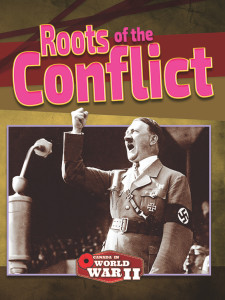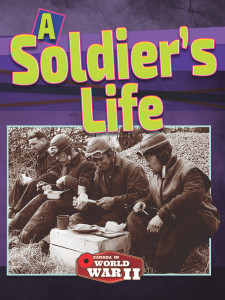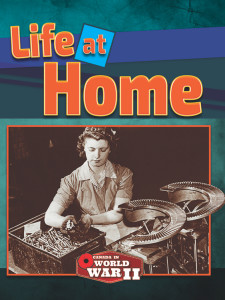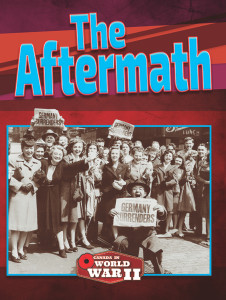| ________________
CM . . .
. Volume XXII Number 21. . . .February 5, 2016

 |
Roots of the Conflict. (Canada in World War II).
Simon Rose.
Calgary, AB: Weigl, 2016.
32 pp., pbk., hc. & ebook, $12.28 (pbk.), $23.96 (hc.).
ISBN 978-1-4872-0312-2 (pbk.), ISBN 978-1-4872-0311-5 (hc.), ISBN 978-1-4872-0313-9 (ebook).
Subject Heading:
World War, 1939-1945-Causes-Juvenile literature.
Grades 4 and up / Ages 9 and up.
Review by Dave Jenkinson.
**** /4
|
| |
|
 |
Battles. (Canada in World War II).
Simon Rose.
Calgary, AB: Weigl, 2016.
32 pp., pbk., hc. & ebook, $12.28 (pbk.), $23.96 (hc.).
ISBN 978-1-4872-0315-3 (pbk.), ISBN 978-1-4872-0314-6 (hc.), ISBN 978-1-4872-0316-0 (ebook).
Subject Headings:
World War, 1939-1945-Canada-Juvenile literature.
Canada-History-1939-1945-Juvenile literature.
World War, 1939-1945-Campaigns-Western Front-Juvenile literature.
Grades 4 and up / Ages 9 and up.
Review by Dave Jenkinson.
**** /4
|
| |
|
 |
A Soldier’s Life. (Canada in World War II).
Simon Rose.
Calgary, AB: Weigl, 2016.
32 pp., pbk., hc. & ebook, $12.28 (pbk.), $23.96 (hc.).
ISBN 978-1-4872-0318-4 (pbk.), ISBN 978-1-4872-0317-7 (hc.), ISBN 978-1-4872-0319-1 (ebook).
Subject Headings:
Canada-Armed Forces-Military life-History-Juvenile literature.
Canada-Armed Forces-Military life-History-World War, 1939-1945-Juvenile literature.
Canada-History-1939-1945-Participation, Canadian-Juvenile literature
World War, 1939-1945-Canada-Juvenile literature.
Grades 4 and up / Ages 9 and up.
Review by Dave Jenkinson.
**** /4
|
| |
|
 |
Life at Home. (Canada in World War II).
Simon Rose.
Calgary, AB: Weigl, 2016.
32 pp., pbk., hc. & ebook, $12.28 (pbk.), $23.96 (hc.).
ISBN 978-1-4872-0321-4 (pbk.), ISBN 978-1-4872-0320-7 (hc.), ISBN 978-1-4872-0322-1 (ebook).
Subject Headings:
World War, 1939-1945-Canada-Juvenile literature.
Canada-History-1939-1945-Juvenile literature.
Grades 4 and up / Ages 9 and up.
Review by Dave Jenkinson.
**** /4
|
| |
|
 |
The Aftermath. (Canada in World War II).
Simon Rose.
Calgary, AB: Weigl, 2016.
32 pp., pbk., hc. & ebook, $12.28 (pbk.), $23.96 (hc.).
ISBN 978-1-4872-0324-5 (pbk.), ISBN 978-1-4872-0323-8 (hc.), ISBN 978-1-4872-0325-2 (ebook).
Subject Headings:
Canada-History-1945-1963-Juvenile literature.
Reconstruction (1939-1951)-Juvenile literature.
Grades 4 and up / Ages 9 and up.
Review by Dave Jenkinson.
**** /4
|
| |
|

excerpt:
The Roots of War
The beginning of World War II was marked by Germany’s invasion of Poland on September 1, 1939. However, the invasion was not the cause of the war. There had been tensions between different countries in Europe and Asia for years. Some issues dated back to the end of World War I in 1918. (From Roots of the Conflict.)
The Battle of Ortona 1943
The Battle of Ortona took place between Canadian and German forces in southern Italy in late 1943. The Allies wanted to gain control of Ottona’s port, as it was one of the few ports in the country capable of docking large ships. If the Allies could capture the port, they would have a faster route for getting supplies to the front line. Allied commanders expected the town to be taken easily. They believed that the Germans would retreat because the Allied advance could cut them off from escape routes and trap them in the city. (From Battles.)
Prisoners of War
Military personnel captured by the enemy during wartime are known as prisoners or war, or POWs. Approximately 9,000 Canadians became POWs during World War II. These included soldiers captured in battles, airmen captured when their planes went down, and sailors taken when their ships were sunk. Hundreds died while in captivity. (From A Soldier’s Life.)
On the Home Front
In 1942, Canadians began receiving ration books. These books were created to limit purchases of goods that were needed for the war effort. Rationing made sure that there would be enough supplies for both civilians and the armed forces. (From Life at Home.)
Making Peace
In early 1945, Canadian troops were involved in fighting in northwest Europe. They suffered heavy casualties in the Battle of the Rhineland in northern Germany. Canadians also fought in the Netherlands in the spring, liberating the country from German occupation in early May. The war in Europe was over when Germany finally surrendered to the Allies on May 8. (From The Aftermath.)
In 2014, Simon Rose authored five books that bear the same titles as the quintet presently being reviewed, but those earlier books were in the “Canada in World War I” series while these make up the "Canada in World War II" series. As was the case with the earlier series, it is important to note the word Canada in the series' title since the books focus particularly on Canada's role in World War II and the impacts that conflict had on Canada both during and after the conflict.
Because each 32 page book is part of a series, it is not surprising that the volumes have a similar structure which consists of 13 two-page "chapters", a one-page 10 item "Test Your Knowledge" content recall quiz (with answer key), a one-page "Further Resources" section containing four websites, and a closing page that is shared by a glossary and an index, with the former providing definitions of 16 to 22 words that had appeared in bold print in the main text.
The books share some internal similarities as well, with one being a two-page timeline which is specific to each book's contents. For example, the timeline for Roots of the Conflict spans the period from 1918-1939 while that of The Aftermath covers 1945-1952. Another common feature is a two-page biography section that identifies six individuals, not always Canadians, who were significant in terms of that particular book's contents. Battles’s biographical section, for instance, is titled "Canadian Commanders" and highlights six generals who were in charge of Canadian troops in Europe's battlefields. That same section in A Soldier's Life is headed "Heroic Canadians", and it identifies a half dozen brave members of Canada's military, all males. A "By the Numbers" page also appears in each volume, with the statistics it provides being germane to the specific book's contents. Consequently, Roots of the Conflict presented the strengths of the opposing forces during World War II while Battles displayed Canadian Army, Air Force and Navy casualty statistics in terms of killed, wounded, taken prisoner and died while a prisoner.
Underlining that these five volumes are aimed at a school market is the inclusion of a "suggested" project that appears in each just before the "Test Your Knowledge" page. That for The Aftermath reads as follows.
The Seeds of War
Almost as soon as World War II ended, the Cold War began. The Cold War continued until the Soviet Union collapsed in 1991, a span of more than 45 years. Even though the key players never engaged in battle, the conflict was fought in other ways and lasted far longer than either of the previous World Wars. How and why did the Cold War begin, and why was it able to last so long?
Using the Internet, books from the library, and any other resources you can find, research what aspects of World War II contributed to the Cold War and allowed the conflict to continue. Be sure to examine the following areas:
* The different political and economic systems used by the opposing sides.
* Events during World War II that sowed the seeds of future conflict.
* What reasons the former allies may have had to distrust each other after World War II.
* The motivations of the leaders on both sides.
* Events that happened in the years following World War II that impeded a resolution to the conflict.
Draw a concept web based on your research. Then, use your concept web to write a report on your findings.
That "assignment" is then followed by a sample concept web.
All of the books are generously illustrated with a mixture of black and white and full-colour period photos, and each contains one or more maps appropriate to its subject matter. Small text boxes, apart from the main text, add additional information. For example, in Life at Home, a text box provides a detail about the conditions in Canada while the war was being fought overseas:
“I never once bought a pair of nylon stockings until 1945. In summer we tinted our legs. Some women even managed the acrobatics required to draw a seam up the back of each leg.”
Gladys Arnold,
Canadian journalist
Paying attention to the opening "chapter" in each book is most important as its contents are then expanded upon in the rest of the book. In the first excerpt above, taken from Roots of the Conflict, author Rose references the commonly described "cause" of World War II, the invasion of Poland by German forces, but he uses the rest of that page to briefly introduce the "real" causes, and these causes are then expanded upon in the remainder of the book.
In Battles, Rose particularly focuses on Canada's military contributions to the war. especially in terms of soldiers (as opposed to sailors or airmen), and he highlights Canada's significant participation in four battles: the Dieppe Raid (1942), the Battle of Ortona (1943), Juno Beach (1944) and the Liberation of the Netherlands (1944-45).
As the title of A Soldier's Life implies, this volume attempts to give 21st century youngsters an idea of what it was like to be an ordinary soldier fighting in Europe. The contributions of Canada's navy, especially its role in the Battle of the Atlantic, and the many roles that the Royal Canadian Air Force played are also highlighted. A section titled “Women at War” focuses on the 45,000 servicewomen who served in the Canadian Women’s Army Corps, the Canadian Women’s Auxiliary Air Force and the Women’s Royal Canadian Naval Service.
Life at Home examines a number of ways in which the war brought changes to Canadian society, including the transition of Canada’s economy from agricultural to industrial and the larger role that the national government came to play in the daily lives of ordinary Canadians. As occurred in World War I, women were called upon to fill the jobs vacated by the men who had enlisted. Rose also devotes a chapter to the interment of Japanese Canadians.
Finally, The Aftermath considers some of the longer term consequences of World War II for Canada, including various economic, political and social impacts.
This series is an excellent introduction to, and overview of, Canada's participation in World War II. Overlap in content between/among the volumes is minimal. If budget is a concern, consider purchasing Roots of the Conflict and The Aftermath in hardcover and one or more of the other volumes in paperback or ebook format.
Highly Recommended.
Dave Jenkinson, CM's editor, lives in Winnipeg, MB. Both his birthfather and his stepfather served in World War II, with the former being a member of the RCAF and stationed in Britain while the latter was a soldier with the Royal Winnipeg Rifles and involved in the liberation of Holland.

To comment
on this title or this review, send mail to cm@umanitoba.ca.
Copyright © the Manitoba Library Association. Reproduction for personal
use is permitted only if this copyright notice is maintained. Any
other reproduction is prohibited without permission.
Next Review | Table of Contents For This Issue - February 5, 2016
CM Home | Back Issues
| Search
| CM Archive
| Profiles Archive
|




